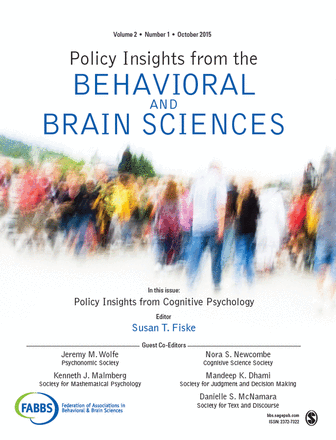Improving STEM and Attracting Students through Cognitive Science
![]() Ever since the Soviet Union launched Sputnik I into orbit more than 50 years ago, the United States has pushed to improve undergraduate instruction in STEM—science, technology, engineering and mathematics.
Ever since the Soviet Union launched Sputnik I into orbit more than 50 years ago, the United States has pushed to improve undergraduate instruction in STEM—science, technology, engineering and mathematics.
In 2009, President Obama made another case for STEM, highlighting the need for dedicated professionals to combat climate change, chronic diseases and other worldwide problems.

The Federation of Associations in Behavioral and Brain Sciences, or FABBS, with SAGE, the parent of Social Science Space, publishes the journal Policy Insights from the Behavioral and Brain Sciences. This annual journal features research findings in the sciences of mind, brain, and behavior that are applicable to nearly every area of public policy. The second issue features 22 articles focused on cognitive psychology focused on topics including education, health, evaluating and mitigating risk, law, and improving society.
Although some reform of undergraduate STEM education has been made, the research reviewed by Charles Henderson, Jose Mestre and Linda Slakey notes that there has been no major transformation.
In “Cognitive Science Research Can Improve Undergraduate STEM Instruction: What Are the Barriers?” Henderson et al. explain that cognitive science and STEM education researchers have come up with ways to improve STEM education but that their strategies are not being converted into practice.
One strategy would have students trade in textbooks for multimedia pre-lectures. The researchers cite earlier findings showing that students learning from the multimedia pre-lectures scored 0.8 standard deviations higher than those learning from the textbook.
Other strategies include interleaved practices, in which assignments and exams include material from previously covered material, rather than proceeding in a traditional, linear fashion, and distributing study over time rather than concentration on one single setting.
These strategies are not being applied in any meaningful way in part because STEM instructors are not aware of them, the paper states. Additionally, there are barriers to translating clinical findings to a natural educational environment.
These barriers include faculty departmental norms, expectations about content coverage, student expectations, classroom structures and class size. “These factors represent significant situational constraints to adoption of new pedagogies,” the paper states, citing research from 2010 and 2007.
The researchers recommend policy implementations to remove the barriers and encourage collaboration between cognitive science and STEM discipline-based education research.
A “key lever,” they state, would be for all the STEM disciplines to place a high value on the work at the boundaries of the discipline. “Characterizing work as ‘peripheral’ tends to carry a negative connotation,” the paper states; thus the core ideas of any discipline remain largely unknown outside its circles. Instead of isolation, the results from one discipline should inform the work of neighboring disciplines.
Since academic departments are “a critical locus” for change in higher education, cognitive scientists should collaborate on work that addresses the mind-set of the faculty, the paper recommends.
The researchers add that it is “critically important” that change be systemic. With the right policies, the connection between cognitive scientists and disciplinary instructors could be improved to where the ideas of cognitive scientists flow more readily into practice.

























































































